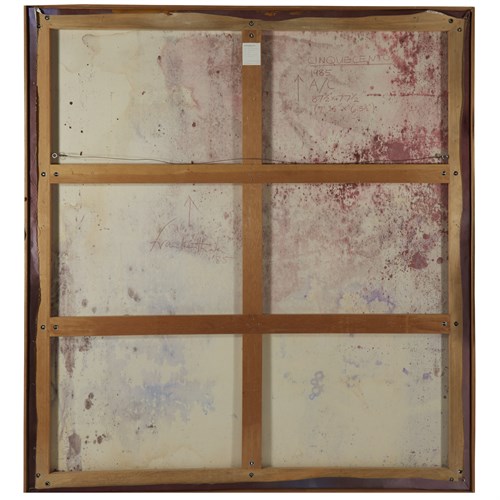June 4, 2018 12:00 EST
18 Works from the Bachman Collection
10
Helen Frankenthaler (American, 1928-2011)
Cinquecento
Signed bottom right, signed again and dated '85 verso, acrylic on canvas.
87 1/2 x 77 1/2 in. (222.3 x 196.9cm)
Provenance: Heath Gallery, Atlanta, Georgia.
The Estate of Lee & Gilbert Bachman, Atlanta, Georgia & Boca Raton, Florida (acquired directly from the above in 1986).
NOTE:
This lot is accompanied by a photocopy of the bill of sale from The Heath Gallery, Atlanta, Georgia.
Sold for $598,000
Estimated at $300,000 - $500,000
Signed bottom right, signed again and dated '85 verso, acrylic on canvas.
Provenance: Heath Gallery, Atlanta, Georgia.
The Estate of Lee & Gilbert Bachman, Atlanta, Georgia & Boca Raton, Florida (acquired directly from the above in 1986).
NOTE:
This lot is accompanied by a photocopy of the bill of sale from The Heath Gallery, Atlanta, Georgia.
Painted in sweeping layers of ochre, umber, sienna, grey and azure blue, Cinquecento evokes the palette and grandeur of 16th Century Italian art referenced in its title. The artist's signature technique of staining an unprimed canvas with diluted paints is employed to dramatic effect here, with added translucent bands of white that glimmer and oscillate as sunlight might play across its surface, while darker greys and browns add depth, richness and dimension. Indeed, having studied Old Master painting under Paul Feeley at Benington College in her early years, Frankenthaler was surely very familiar with both the rich palettes and chiaroscuro technique (dramatic use of light and shadow) first employed by Renaissance masters Michelangelo, Raphael and Titian. And yet here, Frankenthaler, while referencing these giants of the 16th Century, also eschews their realism and narrative in favor of her loose abstraction.
Cinquecento also shows elements of the artist's employment of cubist-like structural elements that more and more become counterpoints to her stains in pictures of the mid-1980s onwards. Here, the gold band which is more painterly than stained across the top announces the composition's vertical boundary, while out of the shimmering sienna and play of white light at center emerge vertically undulating lines that gently announce and define the right side of the canvas. In a final, decidedly intentional punctuation mark, the solitary azure blue orb at bottom left serves as a pointed contrast to the organic fluidity that pervades the canvas.
The artist herself relished the exploration of simultaneously contrasting techniques and elements within a single picture: "My feeling [is] that a successful abstract painting plays with space on all different levels, different speeds, with different perspectives, and at the same time remains flat... For me the most beautiful pictures of any age have this ambiguity" (A. Rowley, Helen Frankenthaler, p. 46).


